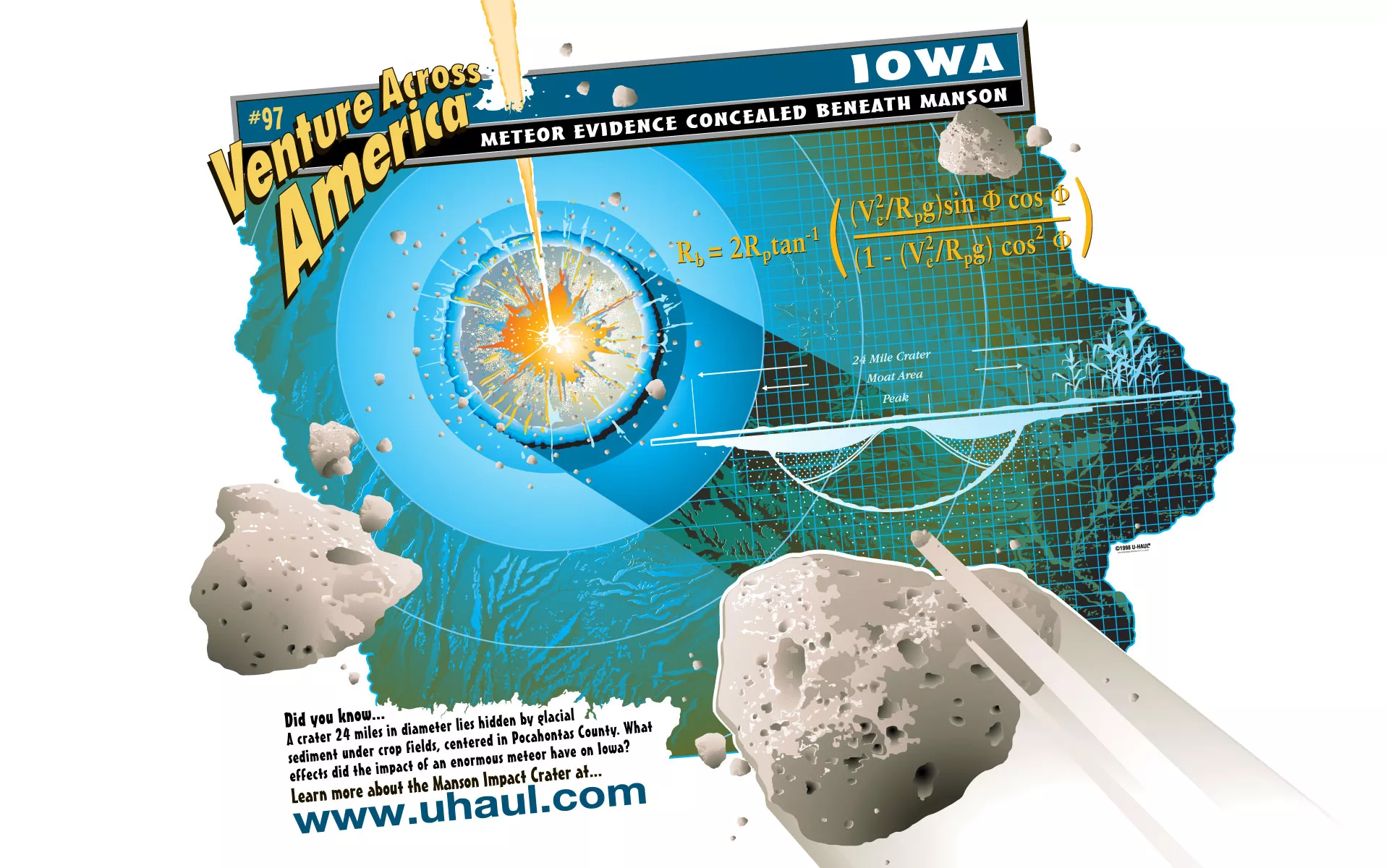Manson Impact Structure
"It is the remains of a mountain - sized meteorite that plowed into the ground in northwest Iowa near Manson, about 74 million years ago."
"...the samples we're looking at were formed by an event so powerful, it shattered the very bedrock into pieces, some the size of pinheads, hurled the fragments for miles around to be mixed with other rocks of different vintages, and liquified the earth into a cauldron of molten rock wider than an Iowa county."
- IowaOutdoors Vol. 67, Iss 4.


Location of Manson Impact Structure by Raymond R. Anderson
Impact Materials
During 1991-1992 12 research cores were drilled into the Manson Impact Structure. As a result the researches found 6 main types of impact materials unique to the impact.

- Crystalline Basement Blocks - Large blocks of crystalline basement materials lifted up over 5 km with the crater's central peak.
- Crystalline Clast Breccia with Sandy Matrix - Blocks of brecciated crystalline rocks in a matrix of disaggregated crystalline rock and mineral fragments.
- Crystalline Clast Breccia with Melt Rock Matrix - Blocks of brecciated crystalline rocks and mineral grains (dominantly quartz) in a melt rock matrix.
- Keweenawan Clast Breccia - Clasts of brecciated dark gray to black Keweenawan (Middle Proterozoic) shales, siltstones, and sandstones mized with light gray - green, devitrified melt rock.
- Phanerozoic Clast Breccia - A matrix - dominated breccia composed primarily of clast of Cretaceous marine shale clasts with lesser numbers of Paleozoic carbonate clasts, rare clasts of Proterozoic Keweenawan clastic rocks, and very rare clasts of crystalline rock and melt rocks in a medium gray calcareous sandy shale matrix.
- Impact Ejecta - An overturned flap of latest ejecta on the terrace terrane.
This information was obtained from the Abstract: Impact Materials Recovered By Research Core Drilling In The Manson Impact Structure by R.R. Anderson, B.J. Witzke, and J.B. Hartung
Manson Impact Structure Morphology
The Form and Structure of the crater's impact
By Raymond R. Anderson

Study of the Manson Impact Structure (MIS) Drill cores, cutting samples from water wells, and seismic data has led to a good understanding of the geometry of the well-preserved impact structure. The sequence of events that formed the MISwas typical of most complex impact structures (impact structures with central peaks).
A hypervelocity impact excavated a crater by vaporizing, melting, and brecciating target materials, ejecting them form the crater and depositing them as proximal and distal deposits. Additionally, some target material was physically pushed down and out, lifting up the crater rim. At its maximum diameter this cavity is called the transient crater (because it is short-lived).
As the transient crater reached its maximum size, its internal pressures had dissipated sufficiently that it could no longer hold up the uplifted crater rim. Gravity began to pull the uplifted rim down, creating an annulus of down-dropped blocks (the terrace terrane) and forcing up a central peak.
The MIS drill and seismic data define a broad central peak (about 6 km in diameter) and a broad terrace terrane (about 7 km wide) forming an annular ring at the outer edge of the crater.
Fun Facts
- Only Naturally soft water in Iowa - within a few miles outside of Manson, the water changes from soft to hard.
- High Fluroride content in water turns teeth brown - was once a problem but a water purification system was put in place and it is no longer an issue.
- Extremely high salt content in water - was not an issue for townspeople in comparison to the fluoride although increased salt intake is known for high blood pressure and heart disease. The high salt content was removed in the purification system as well.
- In 1905 everyone knew Manson was special - the townspeople found out through drilling a well. The wells in Manson have to be drilled to 1200 feet while the norm for wells is 300 - 400 feet.
- Possibly the reason for the dinosaur extinction - Before better testing was available it was widely thought that the meteor that struck this area caused the extinction of the dinosaurs. It is now known that the meteor that struck current day Manson, IA happened 20 million years before the dinosaurs became extinct. But this meteor definitely killed every living thing in what is current day Iowa including the dinosaurs.
To Learn more about the Manson Impact Structure and to read the full articles/reports please visit the library!
U-Haul SuperGraphics
